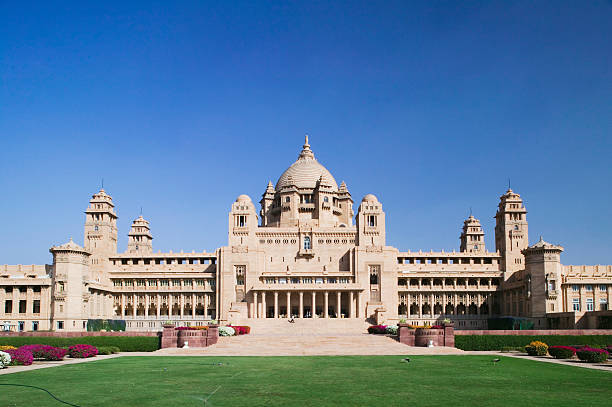
Umaid Bhawan Palace, located in Jodhpur, Rajasthan, India, is a magnificent palace that combines Indian and Western architectural styles. The palace was built by Maharaja Umaid Singh in the 1920s and 1930s, and it is one of the largest private residences in the world. The palace is named after its builder, Maharaja Umaid Singh, who was the last ruling Maharaja of Jodhpur.
The history of Umaid Bhawan Palace is closely tied to the history of the Marwar region and the Jodhpur royal family. The palace was built in the 1920s and 1930s, during a time of great uncertainty in the Marwar region. The region was plagued by drought, famine, and political turmoil, and the Maharaja felt that the construction of the palace would provide employment and a sense of hope for his people.
The palace was designed by Henry Vaughan Lanchester, a British architect, and it is a stunning example of Indo-colonial architecture, with a mix of traditional Rajasthani and Art Deco styles. The palace features a central dome, grand staircases, and beautiful colonnaded verandahs. The palace also features a grand marble throne room, which is adorned with intricate carvings and frescoes.
The palace was built by over 3,000 workers, and it took 15 years to complete. The palace was officially inaugurated in 1943 by Lord Linlithgow, the then Viceroy of India.
After India's independence in 1947, the palace was nationalized and converted into a luxury hotel, and a part of the palace was also converted into a museum, showcasing the rich history and culture of the Marwar region, as well as a collection of personal possessions of the Maharaja and his family.
In recent years, Umaid Bhawan Palace has become a popular destination for film shoots, photo shoots, and destination weddings. The palace offers a unique blend of traditional Indian grandeur and modern luxury, making it a perfect venue for high-end events.
In conclusion, Umaid Bhawan Palace is a magnificent palace located in Jodhpur, Rajasthan, India. It was built by Maharaja Umaid Singh in the 1920s and 1930s, as a response to the famine, drought and political turmoil in the Marwar region. The palace was designed by Henry Vaughan Lanchester and was completed after 15 years. After India's independence, the palace was nationalized and converted into a luxury hotel and a part of the palace was converted into a museum showcasing the rich history and culture of the Marwar region and the Jodhpur royal family. It is now a popular destination for film shoots, photo shoots, and destination weddings.
- Jodhpur Day Tours
- Jaisalmer Taxi Service
- Jodhpur Taxi Service
- Best Taxi Service In Jodhpur
- Best Taxi Service in Jaipur
- Best Taxi Service In Jaisalmer
- Best Taxi Service In Udaipur
- Best Taxi Service In Delhi
- Best Tempo Traveller In Jodhpur
- Best Tempo Traveller In Jaipur
- Best Tempo Traveller In Jaisalmer
- Best Tempo Traveller In Udaipur
- Jodhpur Sightseeing Tour
- Jaipur Sightseeing Tour
- Jaisalmer Sightseeing Tour
- Udaipur Sightseeing Tour
- Delhi Sightseeing Tour
- Hire Tour Guide In Jodhpur
- Hire Tour Guide In Jaipur
- Hire Tour Guide In Jaisalmer
- Hire Tour Guide In Udaipur
- Jodhpur Cabs
- Jaisalmer Cabs
- India Cab Service
- Drive India By Yogi
Comments